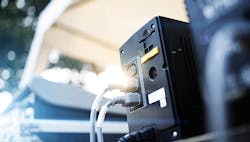Whenever there is a power failure, control is passed to the batteries, where dc voltage is converted to ac for the devices via an inverter. We're not just talking about simple home power outages, with the lights going off or the TV gets turned off; we can start experiencing surges in power, with such a sudden drop guaranteeing our electronics are turned off for a short period of time, a phenomenon referred to as a “brownout.”
The amount of time an uninterruptible power supply (UPS) can keep a system running varies, but it provides enough time for the problem to be resolved or, at the very least, for the systems to be safely shut down.
Also read: Power supply ins and outs
Because a UPS is a system that uses batteries to power a gadget if the power is interrupted, we have batteries and a battery charger. We need to use an inverter to convert the dc current provided by batteries into ac electricity, as this is what our power source uses.
A UPS provides second-level protection but should be partnered with an appropriate surge protection device (SPD) to lengthen the life of the UPS and linked equipment.
In smaller systems, the standby or off-line UPS is the most common kind. Its sole purpose is to wait until there is a power outage before stepping in and immediately delivering electricity. The cost of a standby UPS is generally less than that of other forms of power protection. The line-interactive is similar to a standby online UPS, but it also has the ability to manage voltage automatically. This means it monitors the incoming power supply and can take action if it detects a voltage drop or a spike that causes it to surge excessively. It has the ability to add or remove power in this manner in order to maintain a consistent output to the devices.
In the case of a brownout, as well as power spikes or surges, this type of UPS is quite useful. The double-conversion UPS is effective because battery power, rather than incoming energy, is the primary source of power. There is no transfer switch to close when there is a power outage; therefore, there is no time to switch as with other power supplies. When the incoming power is switched on, the batteries simply charge. Because it converts the ac entering the power supply to dc before returning it to ac for output, it's called a double-conversion. It provides a significantly larger load separation from main supply anomalies in general.
The following are the most common UPS setups. Of course, there are other types that are tailored to a certain shape or purpose, but these are normally designated for more specialized needs.
UPS systems can emit sine waves or simulated sine waves, depending on the model. The sine wave delivers the highest-quality waveform output because it is a smooth, repeating oscillation of ac power. A waveform that approximates the output of a sine wave uses pulse-wave modulation to provide a stepped, approximated sine wave to offer more cost-effective battery backup power for equipment that does not require sine wave output. Because the technology used to create it is less expensive to manufacture, this type of power output is used in standby and line-interactive UPS systems.
Energy-saving UPS systems have become the new industrial mantra. UPS systems that are modular and expandable have the potential to save a lot of energy. As a result, UPS manufacturers are always doing field research and development to guarantee that the design, software, components and energy-storage systems are all compatible to reduce energy losses.
Industry technology has improved substantially in recent years, with an emphasis not just on energy efficiency, but also on minimizing harmonic pollution in the mains and improving power factor correction (PFC). Advanced technologies also offer power solutions that are easily extendable and scalable, as well as fault-tolerant and high-reliability systems with an extremely short mean time between failures (MTBF) and repairable equipment. System MTBF, on the other hand, takes into account the static switch's ability to move the load to a source in the case of a failure. This implies that, if the UPS fails but the static switch successfully shifts the load to another source, the failure isn't considered a true failure. This condition, however, is difficult to verify in practice. The reliability of the rectifier/charger, inverter, static transfer switch, battery and other independent components, often known as component MTBF, is a considerably more important requirement.
About the Author
Shawn Cox
Contributing Editor
Shawn Cox is a licensed master electrician/PLC programmer. He was co-owner/operator of Bobby Cox Electric for 15 years and is currently employed by BMW Manufacturing as an ESA. Contact him at [email protected].

Leaders relevant to this article:


